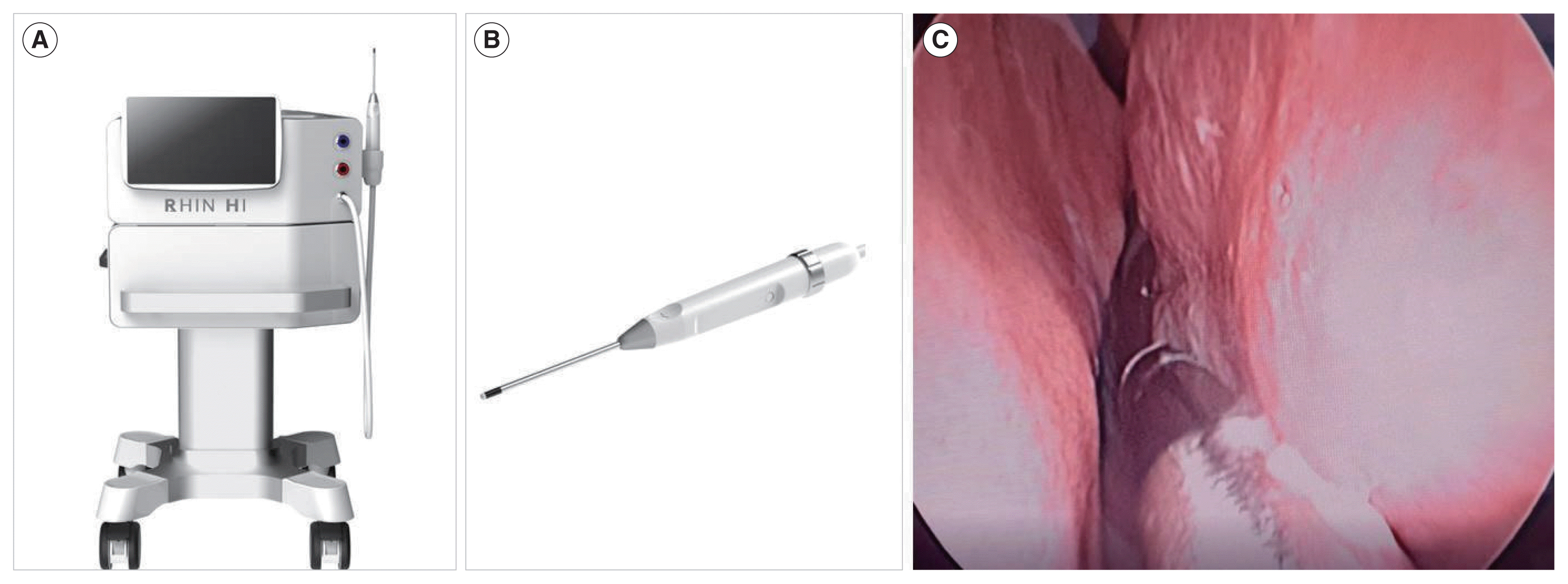INTRODUCTION
MATERIALS AND METHODS
Study design
Procedures
Evaluation
Table 1
Statistical analysis
RESULTS
Participant characteristics
Table 2
Effectiveness
 | Fig. 2Preoperative and postoperative nasal endoscopy examinations. High-intensity focused ultrasound (HIFU; A–D) and coblation (E–H). (A, E) Preoperative nasal endoscopy. (B, F) Endoscopy at postoperative week 2 showed that both HIFU and coblation reduced the volume of the inferior turbinate. Severe crust formation and mild bleeding were observed in the coblation patients, whereas the mucosal layer was completely preserved in the HIFU patients. (C, G) Nasal endoscopy at postoperative week 4. Residual crust was observed, indicating delayed mucosal recovery in the coblation patients. (D, H) The volume of the inferior turbinate was reduced in both groups, and the mucosa had recovered in the coblation patients at postoperative week 12. |
Table 3
| Variable | Preoperative | 2 wk | 4 wk | 12 wk |
|---|---|---|---|---|
| Modified NOSE score | ||||
| Stuffiness | ||||
| HIFU | 2.8±0.4 | 1.4±0.7b) | 0.9±0.6b) | 0.7±0.9a) |
| Coblation | 2.5±0.5 | 1.8±1.0a) | 1.0±0.5b) | 0.7±0.5b) |
| Trouble breathing | ||||
| HIFU | 2.9±0.7 | 1.4±0.7a) | 0.8±0.6b) | 0.4±0.5b) |
| Coblation | 2.5±0.5 | 1.7±1.1 | 0.9±0.6b) | 0.6±0.5b) |
| Trouble sleeping | ||||
| HIFU | 2.9±0.6 | 1.4±0.8b) | 1.0±0.8b) | 0.7±0.9b) |
| Coblation | 2.6±0.7 | 1.9±1.0a) | 0.9±0.7a) | 0.4 ±0.5b) |
| Trouble exercising | ||||
| HIFU | 2.9±0.7 | 1.4±0.8b) | 1.0±0.5b) | 0.7±0.5b) |
| Coblation | 2.4±0.7 | 1.7±0.8a) | 0.8±0.4b) | 0.5±0.5b) |
| NO-VAS score | ||||
| HIFU | 7.01±0.84 | 3.89±1.88b) | 3.38±1.96b) | 2.10±1.63b) |
| Coblation | 6.82±1.11 | 4.86±2.00a) | 2.64±1.56b) | 1.19±0.66b) |
Table 4
| Variable | Preoperative | 2 wk | 4 wk | 12 wk |
|---|---|---|---|---|
| Swelling | ||||
| HIFU | 3.20±0.35 | 1.65±0.71b),c) | 1.55±0.64b) | 1.30±0.54b) |
| Coblation | 3.25±0.42 | 2.65±0.75a) | 1.90±0.77a) | 1.10±0.66b) |
| Discharge | ||||
| HIFU | 1.15±0.91 | 0.95±0.64 | 0.80±0.35 | 0.70±0.59 |
| Coblation | 1.50±0.85 | 1.65±0.94 | 1.15±0.47 | 0.80±0.48 |
| Crust | ||||
| HIFU | 0.40±0.57 | 0.40±0.66d) | 0.30±0.63d) | 0.15±0.24 |
| Coblation | 0.05±0.16 | 2.80±0.63b) | 1.90±0.88a) | 0.50±0.53a) |
DISCUSSION
HIGHLIGHTS
▪ High-intensity focused ultrasound (HIFU) is a new noninvasive treatment modality that focuses an ultrasound beam on the target tissue in the body and generates high energy, causing selective and rapid coagulation necrosis of the target tissue without damaging adjacent tissues or superficial tissues.
▪ In this clinical trial that included 20 adults, HIFU treatment showed improvements comparable to coblation in patients with nasal obstruction due to inferior turbinate hypertrophy.
▪ HIFU can be an effective and safe noninvasive alternative to the current surgical modalities for inferior turbinate hypertrophy.




 PDF
PDF Citation
Citation Print
Print




 XML Download
XML Download